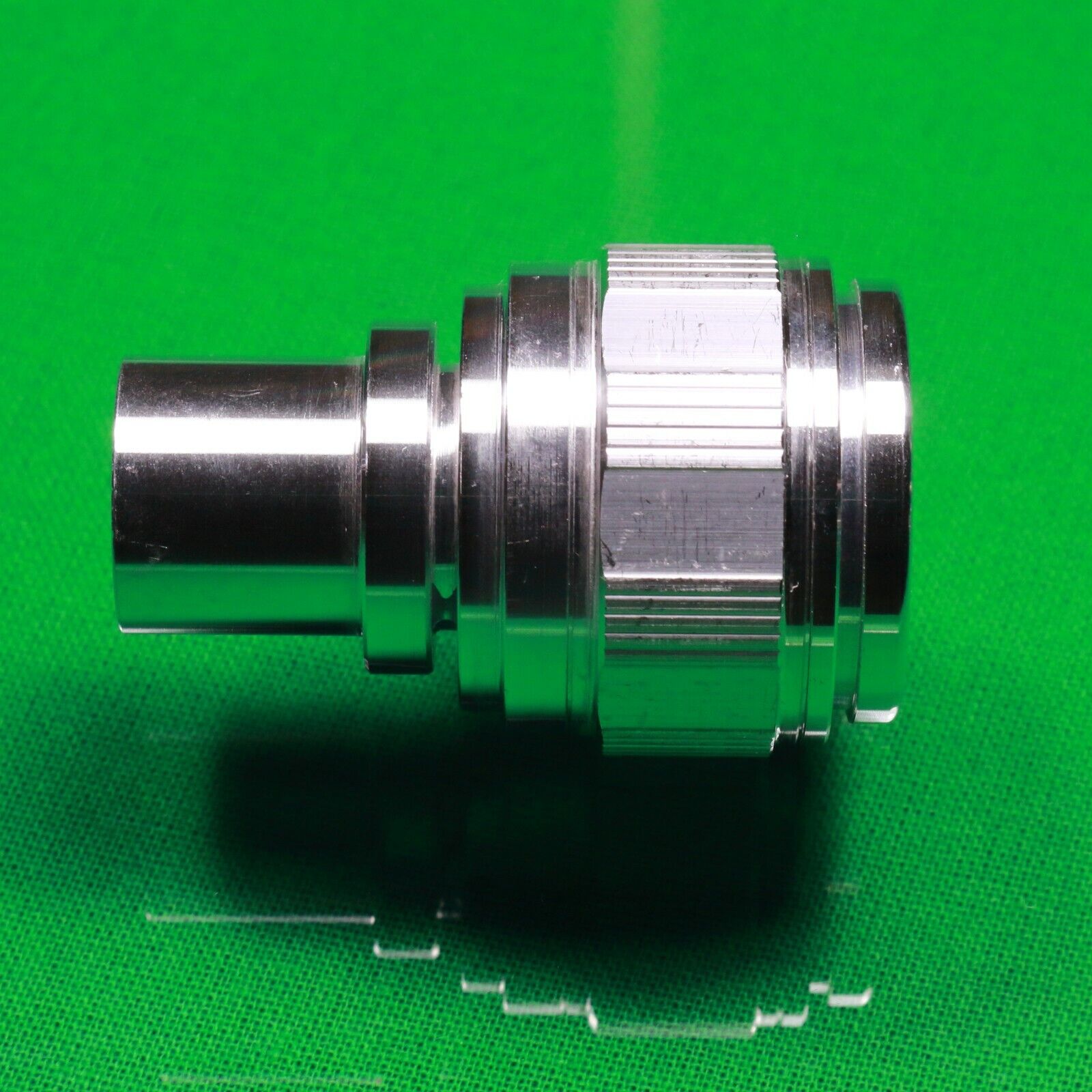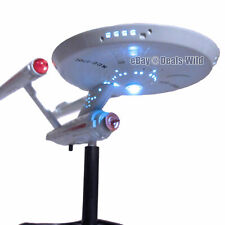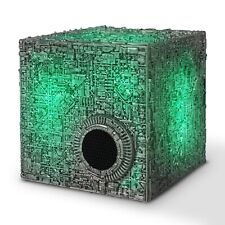Star Trek, Metal LSR 12mm or LED Phaser Nozzle, Mid Grade For Sale

When you click on links to various merchants on this site and make a purchase, this can result in this site earning a commission. Affiliate programs and affiliations include, but are not limited to, the eBay Partner Network.
Star Trek, Metal LSR 12mm or LED Phaser Nozzle, Mid Grade:
$29.99
In general: all parts are shipped with the machine finish as shown in the LISTING PHOTOS. Final finishing is by the Buyer (prop maker) and may include whatever; polishing, graining, distressing, acid washes, electroplating, and other treatments as selected and executed by the Buyer. Most parts will have some cosmetic blemishes that the Buyer may/may-not want to remove or enhance. Thank You.Museum Grade Reproduction, 12mm LSR or LED Ready, fits all types of TOS Phasers
Star Trek Aluminum Alloy Nozzle, 12mm LSR or LED Ready, for all types and brands of P2 Phaser bodies, (acrylic-emitter/12mm LSR not included)PRICE IS FOR EACH ALUMINUM NOZZLE; THE MACHINE MARKS ON THE KNURL FLAT AREAS ARE NOW IDENTICAL TO THE SET USED WCM NOZZLE.
1. LSR Module; remove chrome focus ring from brass-lens-assembly and discard chrome ring only (don't lose the brass lens assembly and related backing-spring).1a. Remember all beams are rectangular (not round).2. Mount LSR Module in a heat-sinking fixture and refocus the now Unfocused lens so the beam is tight.3. I use a $5 aluminum fixture from AiXiz on , mount the heat-sink fixture on a cigar-box with; a switch and battery-power sled.4. Focus at 10 to 20 feet away, wearing safety goggles, so one can observe when the beam-spot appears "tight" on the wall surface.4a. I use a razor (module-off) to turn the brass-lens-assembly as the focus ring was removed in Step One.5. Once focused; Mark the back of the module with a sharpie to indicate the horizontal orientation of the rectangular beam.5a. Consider a drop of Loc-Tight Light (get it on ) on the brass lens assembly to keep it locked in place. Remove excess with Q-Tip.6. Caution, the modules get hot so flip-on & flip-off just long enough to observe the beam spot on the wall.7. Instal the acrylic emitter perfectly square and aligned in the aluminum nozzle.8. A 12mm aluminum rod, with a groove filed at last 1 1/2 inches on the LONG side, makes a great emitter fixture, get the rod on .9. The groove releases any suction that occurs from the vaseline and the post the EPOXY setting of the acrylic emitter.10. NOTE: Groove is very important in 12mm aluminum rod.11. Prior to using this rod-fixture with acrylic emitter and epoxy; coat with vaseline as a glue bond-breaker or the rod will get glued to the aluminum emitter.12. Secure the vaseline coated 12mm rod in a vise LEVEL ALL WAYS, next slide the aluminum nozzle onto the rod, now coat the interior of the aluminum-nozzle emitter hole lightly with epoxy and slide in the emitter giving it a gentle twist (JUST ONE TWIST) to spread the epoxy evenly. Check for alignment and squareness. 12a. After the epoxy sets a few hours; check to see the hole is 100% clear; if not clean out from back with a 5/32 inch drill bit, but by hand (no power tools this step).13. Install the module in the nozzle so the sharpie-line is in-line with the set-screw securement hole (you must tap the pre drilled hole and provide the No. 8-32 set screw).14. Snug the set-screw (not gorilla tight).15. If you observe Splash (splash is the beam coming out straight BUT ALSO bouncing off the interior-wall or the emitter hole) the tips of exacto blades make good shims just insert and snap-off AND YOU CAN usually get the splash to go away.
If results are not good the problems are most likely; (1) focus LSR module chrome focus ring was not removed, (2) 12mm LSR module is too far back in aluminum nozzle as; the focus ring is in-the-way OR, the module is out-of-tolerance and, or the acrylic emitter is glued-in too far back and lastly, (3) the acrylic was installed a little crooked. Troubleshoot and try try again.
CLICK FOR 12mm LSR SHOP DTR-LPF
CLICK; EXPLODED PHASER 12mm LSR SLIDESHOW; YOUTUBE VIDEO
CLICK; AA/DS PHASER-12mm LSR HOW-TO; YOUTUBE VIDEO
CLICK; TOS-PHASER FIN FINISHING; YOUTUBE VIDEO
CLICK; TOS-PHASER SIDE-RAIL FINISHING; YOUTUBE VIDEO
Some Star Trek Prop History For Inquiring Minds:
Most of these Prop Makers and Technicians have passed-on.
Below are old-timer accounts of convention conversations before conventions were really a fad. (all these are therefore 2nd hand stories)
The persons quoted worked for; Desilu and NBC™®, Gene R., and later Paramount™®, (today known as “Paramount +” ™® and CBS ™®).
Mr. Greg Jein was a very well known Star Trek TOS prop collector and authority (born October 31, 1945 in Los Angeles, USA; died May 22, 2022 in Los Angeles). He had personal friendships with all the listed Star Trek TOS production prop craftsmen (Bob Stone, James Rugg, Richard Heimer, John Dwyer, and Mr. Ruck).
Greg was an acquaintance of mine (Jon-Paul L), and generously took the time to meet me in California on several occasions, beginning in 2018 right through 2021. He shall be missed.
Mr. Jein was a filming model designer who, starting in the 1970s’, created miniatures for use in the special effects portions of many films and television series. Mr. Jein was nominated for an Academy Award for Best Visual Effects for “Close Encounters of the Third Kind” (1977) and, nominated for an Outstanding Special Visual Effects Emmy for “Angels in America” (1979).
In the 1970s’ Greg worked onTV productions such as “Wonder Woman”, and “The UFO Incident”. Jein then went on to work on Spielberg's film “1941”, where he and his team constructed a number of models including a twelve-foot model of the Ferris wheel that's dislodged from its mount and rolls down the pier and into the water. For their work on “1941” Jein, William A. Fraker and A. D. Flowers were again nominated for an Academy Award for Best Visual Effects.
Then in the 1980’s Greg Jein was invited to work on “Star Trek: The Motion Picture” building planetary models for Spock's spacewalk scene and the interior of the V'Ger craft. Jein continued his association with Star Trek Films, building alien weapons for: “Star Trek V The Final Frontier”, Starfleet helmets for the assassination scene in “Star Trek VI The Undiscovered Country”. In 1986 for “Star Trek The Next Generation” Jein and a team at Industrial Light & Magic (ALM) built the original six-foot model of the USS Enterprise (NCC-1701-D), the Ferengi Marauder starship and, the Klingon Vor'cha.
BACK TO STAR TREK TOS 1966 THRU 1969
Mr. Bob Stone was Star Trek's machinist and made all the metal prop parts for all three seasons of the show. Parts were made to order for each episode as in those times (the 1960’s) as machining was done by hand and there was no advantage to making short runs (and no studio funding either). Each episode had a specific budget. Speaking of budgets, Bob relied on his Star Trek friend Robert Archer (VP of Budgeting for the show) in getting a little leeway on the $ so he could do the best possible job. According to Bob there was no magic drum of Phaser Nozzles and every job was a mad-dash to meet the filming deadlines.
Because parts were made only to order, parts varied quite a bit. These variations can be seen in all the surviving examples of TOS hand props from Phaser to Communicators and Tricorders. Sometimes it was not that a new design was needed but rather that when one Wings it from a sketch, in a hurry using what is on-hand, you get an unintended-new-version of something (in the 1960’s the TV audience never could see that).
Robert Archer and Bob Stone worked closely together so when the show was canceled suddenly in season three, Robert Archer ended up with a nice collection of hand props.
Richard Heimer made the molds for hand props. He also did all the casting and forming. This included; Vacuum form bucks, Fiberglass molds and urethane molds. Again, according to him most work is done in the normal Hollywood maddening rush. He shared with his convention friends that there were many molds made from molds when the production schedule demanded this. He also shared that when the show ended he rescued the molds from being discarded by putting them in his garage.
James Ruggs (b. 1919) was the director of special effects for the show. He handled and repaired many of the props on-set. When the show was canceled in season three he rescued many hand props and even some models from the scrap heap. Dick Ruben, Prop & Art Assistant on the show, got his Set-Used Klingon disruptor from James. Mr. Ruggs held on to his rather large Star Trek collection for many years. It is widely known that Greg Jein got his Holy-Grail Hero Phaser from James.
In closing a nod to Mr. Ruck, a prop technician, who reported that he repaired some hand props hundreds of times as they were often damaged during filming. He had also shared that the fiberglass Mid-Grade’s, and some other props often used basswood strips between the seams to establish uniform dimensions. Watch some YouTube Star Trek TOS bloopers to see what he was talking about when it comes to repairs and hand props flying apart.
The jonpaultrek2012™® company Supports the right to free expression and the value of the copyright. The purpose of the copyright is to encourage writers, filmmakers and artists to produce the creative works that enrich our culture. All scanning, uploading, and distribution of the content of this web posting without permission is theft of the author's Intellectual Property. if you would like permission to use the material from this website (Other than for the intended review purposes) Please contact me for permission. All new products sold on this website are produced under license From: jonpaultrek2012™® LLC, Florida corporation, located in the United States of America.
INTERNATIONAL ORDER TRANSIT TIMES DEPENDS ENTIRELY ON: (a) THE LOCAL DESTINATION TRANSIT TIMES, AND (b) LOCAL DESTINATION CUSTOMS CLEARANCE TIME.THIS SELLER IS NOT RESPONSIBLE FOR YOUR LOCAL CARRIER AND LOCAL CUSTOMS OFFICE SLOW PROCESSING.TRACK ALL ORDERS THROUGH ANDINQUIRE ON ALL DELAYS BY CONTACTING .

Related Items:
Star Trek USS Enterprise Light Up NCC-1701 Ship Toy Classic TOS Original Series
$24.95
Star Trek U.S.S. Enterprise 1701-D – Enterprise Replica Bluetooth Speaker
$66.49
Star Trek Borg Cube Bluetooth Speaker with Green Illumination and Borg Sound FX
$66.49



